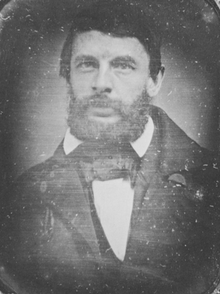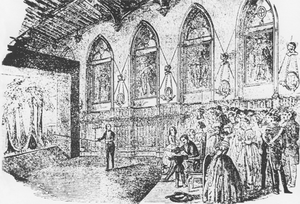John Banvard

John Banvard (November 15, 1815 – May 16, 1891) was a US panorama and portrait painter known for his panoramic views of the Mississippi River Valley.
Biography
John Banvard was born in New York and was educated in high school. When his father went bankrupt, he began to travel around the United States, and supported himself with paintings he exhibited.

In 1840 he began to paint large panoramas of the whole Mississippi River valley. He traveled through the area in a boat, made preliminary drawings and supported himself with paintings and hunting. He combined the preliminary sketches and transferred them to a canvas in a building erected for this purpose in Louisville, Kentucky. His largest panorama began as 12 feet (3,6 m) high and 1300 feet (369 m) long and was eventually expanded to about half a mile (about 800 meters) although it was advertised as a "three-mile canvas". It toured around the nation, and was eventually cut up into hundreds of pieces, none of which still exist today.

Scientific American magazine published a piece under "New Inventions" in its issue of December 16, 1848, describing and illustrating Banvard's mechanism for displaying a moving panorama.
In 1846 he began to travel with this panorama in Europe, Asia and Africa and even gave Queen Victoria a private viewing. His portrait was painted in 1849 by the English artist Anna Mary Howitt.[1] During his travels he also painted panoramas in Palestine and the Nile River Valley.
Banvard had a rivalry with panorama performers John Rowson Smith and Richard Risley Carlisle. Banvard called them imitators and "unprincipled persons".[2] They in turn referred to the "crude efforts of the uncultivated artist" Banvard.[3] Banvard suggested that Smith and Carlisle's panorama was actually painted by George Catlin, who had copied the image after his own panorama.[4]
On his return his invested part of the fortune he had made in 60 acres (240,000 m2) overlooking Cold Spring Harbor on the North Shore of Long Island, where in 1852-55, in competition with P. T. Barnum's palace "Iranistan" in Bridgeport, Connecticut, he proceeded to design and have built a baronial residence from its eastern shore, which, it was given out, was intended to resemble Windsor Castle; he named the place Glenada, the glen of his daughter Ada, but the locals called it "Banvard's Folly".[5] After his death it became a fashionable resort hotel, The Glenada.
The Brooklyn-based history band Pinataland recorded a song about Banvard's travails for their 2008 album "Songs for the Forgotten Future Vol. 2".
See also
| Wikimedia Commons has media related to John Banvard. |
References
- ↑ Retrieved 9 July 2011.
- ↑ Hanners, John. "It was Play Or Starve": Acting in the Nineteenth Century American Popular Theatre. Bowling Green State University Popular Press, 1993: 51. ISBN 0-87972-587-7
- ↑ Huhtamo, Erkki. Illusions in Motion: Media Archaeology of the Moving Panorama and Related Spectacles. Cambridge, MA: MIT Press, 2013: 187–188. ISBN 9780262018517
- ↑ Hanners, John. "It was Play Or Starve": Acting in the Nineteenth Century American Popular Theatre. Bowling Green State University Popular Press, 1993: 51–52. ISBN 0-87972-587-7
- ↑ John Hanners, "It was play or starve: acting in the nineteenth century American popular theater", (Bowling Green State University Popular Press) 1993, pp. 71f; Estelle V. Newman, "The Story of Banvard's Folly," Long Island Forum 15.5 (May 1952): 83-84 and 95-97.
Further reading
- Dorothy Dondore. Banvard's Panorama and the Flowering of New England. The New England Quarterly, Vol. 11, No. 4 (Dec., 1938), pp. 817–826.
- John Hanners. A Tale of Two Artists: Anna Mary Howitt's Portrait of John Banvard. Minnesota History, Vol. 50, No. 5 (Spring, 1987), pp. 204–208.
- Paul S. Collins. Banvard's Folly: Thirteen Tales of People Who Didn't Change the World (ISBN 978-0312300333).
- "The Holy Land" Gleason's Pictorial Drawing-Room Companion Vol. 7 No. 25 (1854-12-23):388-9. Online at Internet Archive.
- "Banvard, the Artist, and His Residence" Ballou's Pictorial Drawing-Room Companion Vol. 12 No. 20 (1857-05-16):312. Online at Internet Archive.
|